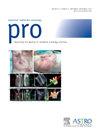低危乳腺癌部分乳房放疗采用mri引导的适应性方法II期PARLOB研究的结果。
IF 3.5
3区 医学
Q2 ONCOLOGY
引用次数: 0
摘要
目的:大多数乳腺癌患者采用保乳手术,术后全乳(WBI)或部分乳房照射(PBI)治疗。先前对PBI的研究表明,与WBI相比,PBI的同侧乳房肿瘤复发率(IBTR)相似,但在毒性和美容结果方面的数据相互矛盾。本研究探讨立体定向mri引导的适应性放疗(SMART)治疗PBI的可行性,重点是毒性和美容结果。方法和材料:纳入符合ESTRO指南的适合PBI的低危乳腺癌患者。SMART以仰卧位进行为期两周的治疗,治疗剂量为6 Gy的5个分数,如果有高危特征则为6.5 Gy。分别在术后3、9、18和36个月对患者和医生报告的毒性和美容结果进行评分。结果:2017-2020年,纳入50例患者,45例患者接受SMART治疗。中位年龄66岁,中位肿瘤大小1.2 cm。大多数肿瘤为Bloom Richardson 1级(55.6%),雌激素受体阳性(95.6%)。大多数患者未接受辅助全身治疗(80%)。急性毒性最高为2级,占20%,以疲劳为主。18个月时,4名患者(9%)报告了2级毒性,包括纤维化和疲劳。没有3级或以上的毒性记录。在9和18个月时,86.4%的患者对美容结果(非常)满意。与对侧乳房相比,18个月时的美容效果分别为90.9%和73.8%。结论:立体定向mri引导下的适应性PBI治疗低危乳腺癌是可行的,且毒副反应率低。随访18个月后,患者报告了良好的美容效果。本文章由计算机程序翻译,如有差异,请以英文原文为准。
Partial Breast Radiation Therapy in Low-Risk Breast Cancer Using a Magnetic Resonance Imaging–Guided Adaptive Approach; Results of the Phase 2 PARLOB Study
Purpose
The majority of patients with breast cancer are treated with breast-conserving surgery followed by postoperative whole or partial breast irradiation (PBI). Previous studies on PBI demonstrated similar ipsilateral breast tumor recurrences compared with whole breast irradiation, however, conflicting data on toxicity and cosmetic outcomes were reported. This study investigates the feasibility of stereotactic magnetic resonance imaging-guided adaptive radiation therapy (SMART) for PBI, with emphasis on toxicity and cosmetic outcomes.
Methods and Materials
Patients with low-risk breast cancer suitable for PBI as defined by European Society for Radiotherapy and Oncology guidelines were included. SMART was delivered in supine position in a 2-week course of 5 fractions of 6 Gy, or 6.5 Gy in case of high risk characteristics. Patient- and physician-reported toxicity and cosmetic outcomes were scored at 3, 9, 18, and 36 months postoperatively.
Results
Between 2017 and 2020, 50 patients were included and 45 patients were treated with SMART. Median age was 66 years, median tumor size was 1.2 cm. Most tumors were Bloom Richardson grade 1 (55.6%) and estrogen receptor positive (95.6%). The majority did not receive adjuvant systemic therapy (80%). The highest grade acute toxicity was grade 2 in 20%, mostly fatigue. At 18 months, 4 patients (9%) reported grade 2 toxicity, consisting of fibrosis and fatigue. No grade ≥3 toxicity was recorded. At 9 and 18 months, 86.4% of patients were (very) satisfied with the cosmetic outcome. The cosmetic outcome was good-excellent compared with the contralateral breast at 18 months in 90.9% and 73.8% as scored by patients and physicians, respectively.
Conclusions
Stereotactic magnetic resonance imaging-guided adaptive PBI for patients with low-risk breast cancer was feasible and resulted in low rates of toxicity. Good cosmetic outcomes were reported by patients after a follow-up of 18 months.
求助全文
通过发布文献求助,成功后即可免费获取论文全文。
去求助
来源期刊

Practical Radiation Oncology
Medicine-Radiology, Nuclear Medicine and Imaging
CiteScore
5.20
自引率
6.10%
发文量
177
审稿时长
34 days
期刊介绍:
The overarching mission of Practical Radiation Oncology is to improve the quality of radiation oncology practice. PRO''s purpose is to document the state of current practice, providing background for those in training and continuing education for practitioners, through discussion and illustration of new techniques, evaluation of current practices, and publication of case reports. PRO strives to provide its readers content that emphasizes knowledge "with a purpose." The content of PRO includes:
Original articles focusing on patient safety, quality measurement, or quality improvement initiatives
Original articles focusing on imaging, contouring, target delineation, simulation, treatment planning, immobilization, organ motion, and other practical issues
ASTRO guidelines, position papers, and consensus statements
Essays that highlight enriching personal experiences in caring for cancer patients and their families.
 求助内容:
求助内容: 应助结果提醒方式:
应助结果提醒方式:


